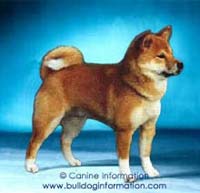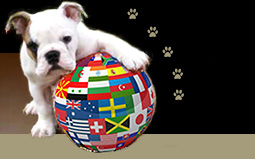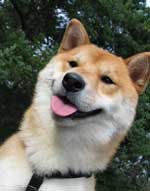.
.
.
.
The Kanji Shiba 柴 originally means "brushwood", "firewood" (i.e. small branches, kindling) and was probably used symbolically to refer to the small size of this breed. Other popular explanations are that the dogs were named after the brushwood bushes where they hunted or after the autumn color of the leaves of these same brushwood bushes which resemble the dog's coat color. The japanese word inu translates into "dog", but modern usage tends to drop the suffix. In translations, these explanations are often combined and the Shiba is then referred to as the "little brushwood dog." These explanations are, however, unlikely. A first indication is that the Japanese translate the Kanji combination Shiba Inu 柴犬 into "midget dog" in English. A second proof is the existence of other words where the Kanji Shiba 柴 is used as a diminutive, for example in 柴 栗 shiba guri, meaning "dwarf chestnut", where shiba stands for "dwarf".
The Shiba dog is also believed to be one of Japan's most ancient breeds.
It is thought that the Shiba came to Japan with the peoples who migrated to Japan from the south in the Jomon Period (about 8000 B.C. to 200 B.C.). Genetic variability studies carried out on a sample of 11 Asian dogs also showed that among the East Asian dog breeds the Shiba exhibited the lowest genetic diversity, indicating again that this is one of the most ancient and most "primitive" of dog breeds.
Like the other native japanese dog breeds they were bred for hunting by ancient hunters of Japan, called matagi and were believed to have special characteristics associated with the concepts of spirit, obedience, loyalty and bravery and their temperaments are always calm and considerate, with great dignity. Their eyes tend to be triangular and recessed, "suggesting the burning spirit within."
By the 1920s the breed had become nearly extinct and all subsequent dogs were bred from only three surviving bloodlines or varieties, the Sanin Shiba, the Shinshu Shiba and the Mino Shiba. World War II and an outbreak of distemper in 1959 further decimated the breed and only the Shinshu Shibas remained in sufficient numbers by that time to rebuild the breed. As a matter of fact, it is the Shinshu variety that the Japanese usually call the Shiba and the breed standard laid down in 1934 is heavily influenced by that type.
The Shiba inu is an agile dog that copes well with mountainous terrain, its original habitat, were it was used on small game and small ground-breeding birds. It is fiercely independent and highly intelligent. Fanciers of the breed compare him to a cat. They are very clean and often groom themselves as a cat would. Like cats they use their front paws to clean their faces and to bat toys. They possess cat-like senses and, just like felines, are nearly too smart to train. Despite these cat-like features they are a true spitz-type breed with the northern dog tendency of aloofness to strangers and an independent character. They are also very cautious and surprising at times. With the Basenji, they share the ability to express their disapproval or other feelings with high-pitched sounds and screams, rather than through barking.
Outside Japan, the breeding of Shibas follows the standard of the FCI written in 1992 and based on the Japanese standard. The FCI standard kept very close to the original standard but breeders outside Japan tend to interpret the standard rather literally, while the Japanese pay more attention to three key elements they consider as essential to judge a Shiba. These three qualities that define a true Shiba dog are:
Kan'i, Ryosei and Soboku.
Kan'i 敢為 is the most important quality a true Shiba should possess. It is sometimes translated as "spirited boldness" and means "well-balanced, courageous and self-confident".
Ryosei 良性 ("good nature") refers to the loyal and obedient character of the Shiba and to his strong senses which make him an ideal home guardian.
Soboku 素樸 refers to the natural beauty of the soul, meaning that a Shiba should be unaffected, cheerful and spontaneous.
Import to the US started in 1977, but due to the reluctance of Japanese breeders (in order to protect the original phenotype and character of the breed, contrary to the evolution of the American Akita) importation has slowed down considerably. Fortunately, certain breeders in the US have succeeded in importing and reproducing original Shibas with the traditional type and temperament. The breed appears in the Miscellaneous Class of the AKC since October 1991. Shibas range in height from 14.5 to 16.5 inches (37 to 42 cm) for males, and 13.5 to 15.5 inches (34 to 39 cm) for females, with males weighing approximately 23 lb (10 kg), and females approximately 17 lb (8 kg). They have double coats, with a straight outer coat and a soft, dense undercoat . The preferred colors are crimson red through pale red, red sesame and black and tan.
This is not a dog for everyone. Prospective owners must be prepared to understand and deal with the spitz-type personality of this dog. Their cheerful character and lively temperament make them ideal children's playmates, but they are also perfectly able to entertain themselves alone for long periods when their owners are busy. If you decide a Shiba is the right breed for you, start your research to find a reputable breeder. Never buy a dog from a puppy mill or pet store. Shibas should be raised indoors, with constant human contact and all the typical noises associated with living in a home within a family. Puppies raised outdoors, in kennel type situations or who spent part of their early live in a pet store conditions may become very anti-social and frightened by everything.























